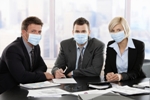
Media Attention Makes Disease Outbreaks Less Severe
Mathematical biologists tout the benefit of publicly reporting disease outbreaks with the news media and use rigorous mathematical techniques to study the impact of that communication.
At the first sign of a disease pandemic, public health officials should begin strongly communicating about the extent of the outbreak and the steps that can be taken by the public to avoid infection, according to two mathematical biologists who have modified the most widely used infectious disease transmission model to account for the impact of news media coverage.
During outbreaks of serious infectious diseases, many individuals closely follow media reports and, as a result, take precautions to protect themselves against the disease. These precautions may include staying home, being vaccinated, avoiding crowds, using disinfectants, canceling travel plans, and wearing face masks. Known as "self-isolation," these precautions can significantly reduce the severity of an outbreak, according to mathematical modeling done by researchers at the Georgia Institute of Technology and Marshall University in Huntington, W. Va.
"The more forcefully the media provides information about pandemic infections and deaths, the more the total number of infections is reduced," said Howard Weiss, a professor in the Georgia Tech School of Mathematics. "Media coverage also reduces the maximum number of infections at any particular time, which is important for allocating the resources needed for treating infectious diseases."
The benefit of publicly reporting disease outbreaks seems obvious, and public health officials in the United States have a policy of regularly communicating with the news media about such incidents. But according to Weiss, not all world governments choose to communicate so well -- and nobody had used rigorous mathematical techniques to study the impact of that communication before.
Epidemiologists use the S-I-R model to anticipate the effect of disease outbreaks. The basic model places individuals into one of three groups signified by each letter of the acronym:
- Susceptible individuals are those who are vulnerable to the disease
- Infected individuals are those who have the disease
- Removed individuals are those who are not in the other groups because they have been vaccinated, have isolated themselves from the population, have already recovered from the disease, or have died.
Weiss and collaborator Anna Mummert, an assistant professor of mathematics at Marshall University, modified the model to take into account ways individuals could move from the "Susceptible" group to the "Removed" group without passing through the "Infected" group. By "self-isolating" as a result of news media warnings, they reasoned, individuals could move directly into the "Removed" class because they are no longer susceptible. "On a chart showing the number of infected people at any one time, as you increase the intensity of the media coverage, you substantially decrease the number of infections," Weiss noted. "We are assuming that people self-isolate at a rate that is proportional to the amount of media coverage, though we would like to study that in more detail."
The sooner the media coverage of a pandemic begins, the fewer individuals will ultimately be infected. But Weiss said the model shows that almost any media coverage is helpful at reducing the extent of a pandemic. "Telling the public always helps, but the longer you wait, the less it helps," he said. "If you wait long enough, the effect of media coverage is essentially negligible."
In a paper about the model submitted to a biostatistics journal and posted on the Physics arXiv blog, Mummert and Weiss describe testing their model with a hypothetical outbreak of Ebola Hemorrhagic Fever in Huntington, a college community of about 50,000 residents. They also tested the model on a long-term infection, HIV. In the case of pandemics that occur over a long period of time, regular coverage by the news media may be required to maintain a lower infection rate.
In their model, Mummert and Weiss did not look at such issues as the quality of news coverage or what may happen if news reports turn out to be false or overstated. They also didn't study the effect of individuals occasionally leaving their isolation to purchase food or medicine, for instance. The paper cites the case of a false rumor spread across the Internet in 2003 about a restaurant worker in New York's Chinatown who had supposedly died of the SARS infection. That rumor led to a decrease in travel to that area. Likewise, they noted, a recommendation from the Centers for Disease Control and Prevention in 2003 to avoid nonessential travel to SARS-infected nations led to a dramatic reduction in travel to those areas.
Weiss acknowledged strong communications about dreaded diseases such as Ebola could create public panic. In those rare cases, public health officials will have to weigh the benefits against the risks. "In general, our advice to public health officials anywhere in the world is not to hold back," he said. "They should get out the news about infectious disease outbreaks loudly and quickly. It's clear that vigorous media reporting can have a substantial effect on reducing the impact of an outbreak."